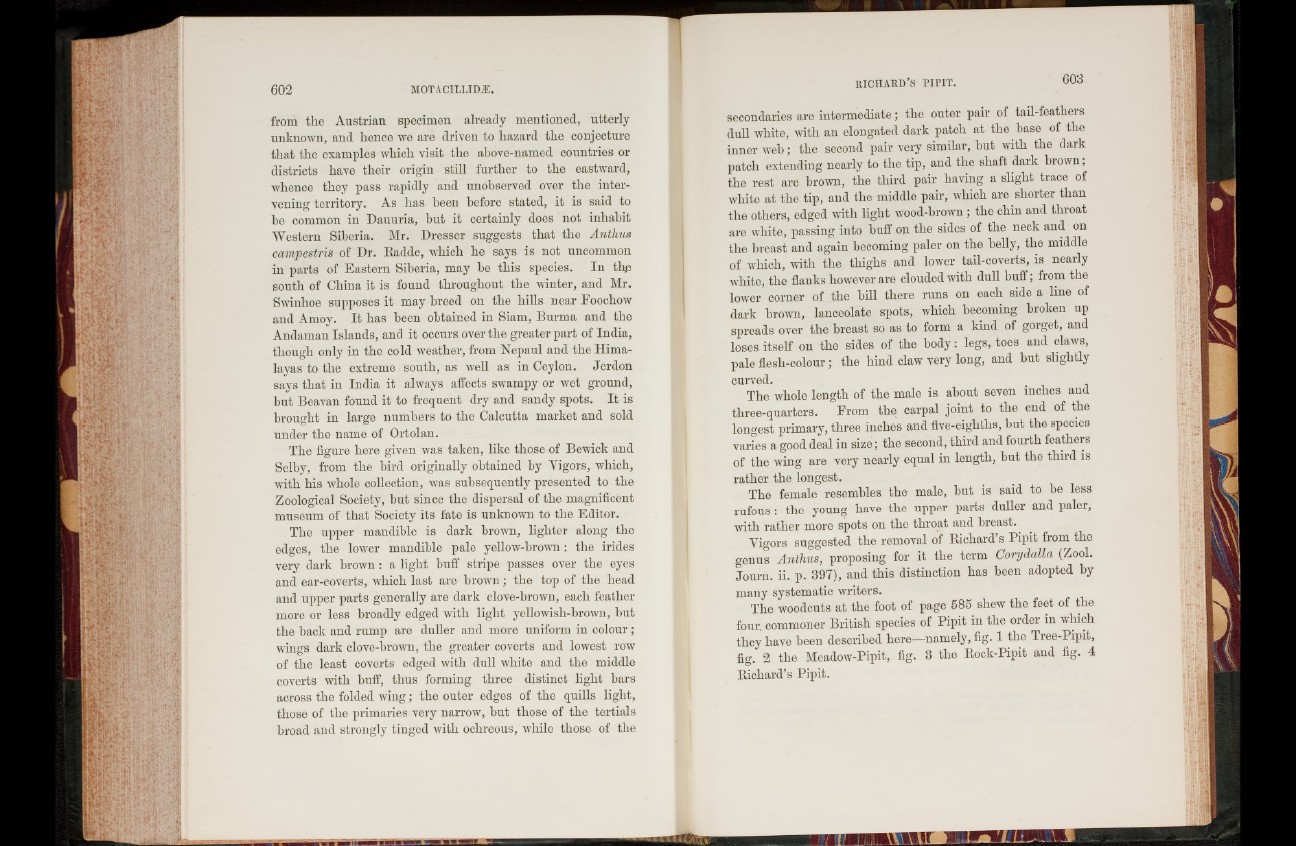
from the Austrian specimen already mentioned, utterly
unknown, and hence we are driven to hazard the conjecture
that the examples which visit the above-named countries or
districts have their origin still further to the eastward,
whence they pass rapidly and unobserved over the intervening
territory. As has been before stated, it is said to
be common in Dauuria, but it certainly does not inhabit
Western Siberia. Mr. Dresser suggests that the Anthus
campestris of Dr. Radde, which he says is not uncommon
in parts of Eastern Siberia, may be this species. In thp
south of China it is found throughout the winter, and Mr.
Swinlioe supposes it may breed on the hills near Foochow
and Amoy. I t has been obtained in Siam, Burma and the
Andaman Islands, and it occurs over the greater part of India,
though only in the cold weather, from Nepaul and the Himalayas
to the extreme south, as well as in Ceylon. Jerdon
says that in India it always affects swampy or wet ground,
but Beavan found it to frequent dry and sandy spots. I t is
brought in large numbers to the Calcutta market and sold
under the name of Ortolan.
The figure here given was taken, like those of Bewick and
Selby, from the bird originally obtained by Vigors, which,
with his whole collection, was subsequently presented to the
Zoological Society, hut since the dispersal of the magnificent
museum of that Society its fate is unknown to the Editor..
The upper mandible is dark brown, lighter along the
edges, the lower mandible pale yellow-brown: the irides
very dark brown: a light buff stripe passes over the eyes
and ear-coverts, which last are brown; the top of the head
and upper parts generally are dark clove-brown, each feather
more or less broadly edged with light yellowish-brown, but
the back and rump are duller and more uniform in colour;
wings dark clove-brown, the greater coverts and lowest row
of the least coverts edged with dull white and the middle
coverts with buff, thus forming three distinct light bars
across the folded wing; the outer edges of the quills light,
those of the primaries very narrow, but those of the tertials
broad and strongly tinged with ochreous, while those of the
I l l— ll mmm— ! - ■
secondaries are intermediate; the outer pair of tail-feathers
dull white, with an elongated dark patch at the base of the
inner web; the second pair very similar, but with the dark
patch extending nearly to the tip, and the shaft dark brown;
the rest are brown, the third pair having a slight trace of
white at the tip, and the middle pair, which are shorter than
the others, edged with light wood-brown; the chin and throat
are white, passing into buff on the sides of the neck and on
the breast and again becoming paler on the belly, the middle
of which, with the thighs and lower tail-coverts, is nearly
white, the flanks however are clouded with dull buff; from the
lower corner of the bill there runs on each side a line of
dark brown, lanceolate spots, which becoming broken up
spreads over the breast so as to form a kind of gorget, and
loses itself on the sides of the body: legs, toes and claws,
pale flesh-colour; the hind claw very long, and but slightly
curved.
The whole length of the male is about seven inches and
three-quarters. From the carpal joint to the end of the
longest primary, three inches and five-eighths, but the species
varies a good deal in size; the second, third and fourth feathers
of the wing are very nearly equal in length, but the third is
rather the longest.
The female resembles the male, but is said to be less
rufous: the young have the upper parts duller and paler,
with rather more spots on the throat and breast.
Vigors suggested the removal of Richard’s Pipit from the
genus Anthus, proposing for it the term Corydalla (Zool.
Journ. ii. p. 397), and this distinction has been adopted by
many systematic writers.
The woodcuts at the foot of page 585 shew the feet of the
four, commoner British species of Pipit in the order m which
they have been described here—namely, fig. 1 the Tree-Pipit,
fig. 2 the Meadow-Pipit, fig. 3 the Rock-Pipit and fig. 4
Richard’s Pipit.